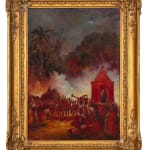French School
Untitled (South Indian Festival), circa 1890-1920
Oil on canvas
41 x 27 cm
16 1/8 x 10 5/8 in
16 1/8 x 10 5/8 in
Further images
An early, post-impressionist, 20th Century, oil painting of a South Indian festival, possibly Kerala. During the early 20th century in India most landscape painters worked in watercolour There had been...
An early, post-impressionist, 20th Century, oil painting of a South Indian festival, possibly Kerala. During the early 20th century in India most landscape painters worked in watercolour There had been a flurry of artist's working in oil in the latter part of the 19th century, such as Ravi Varma and Edwin Lord Weeks, but moving into the early 20th century, the period just before the Indian Modern painters arrived on the scene, apart from a few of the Bombay School painters, this genre of oil on canvas was rare.
An energetic painting, this artwork depicts a South Indian festival, possibly in Kerela, showing the Temple cart, the musicians and the fires enrapturing the crowds who dance with fervour at the joy of the celebrations.
The choice of format, the long portrait-oriented canvas is unusual for a landscape painting. It channels our attention and makes us voyeurs. Despite depicting a religious festival the painting is not religious. The Temple Cart is not the focus but instead it is the whole scene and the place that excites the artist. The centre of the image focuses on the energy of the participants; the dancers and musicians cleverly emphasised and highlighted through the light from the fires. It is this light which also allows us to see the palms and the forest.
Night time carries a certain potency and this is used with great effect to emphasise the sights and sounds. The brush work, particularly to the top left-hand quarter of the painting shows us that this is an artist of some repute. The feeling of the depth to the forest is enriched with brush strokes of a multitude of colours.
The label on the back of the painting suggests that this is probably a French canvas. The painting has a looseness of form and application of paint, possibly influenced by French Impressionism.
The frame appears to be a late 18th/ early 19th century frame. It has bits of gilding and small parts of the gesso missing. A framer could easily restore the frame. The frame is just short of covering all the edges of the canvas. However the striped banding on the frame neatly references notions of Orientalism and travel as this banding an be seen on artworks by some of the best Orientalists such as Gérôme.
An energetic painting, this artwork depicts a South Indian festival, possibly in Kerela, showing the Temple cart, the musicians and the fires enrapturing the crowds who dance with fervour at the joy of the celebrations.
The choice of format, the long portrait-oriented canvas is unusual for a landscape painting. It channels our attention and makes us voyeurs. Despite depicting a religious festival the painting is not religious. The Temple Cart is not the focus but instead it is the whole scene and the place that excites the artist. The centre of the image focuses on the energy of the participants; the dancers and musicians cleverly emphasised and highlighted through the light from the fires. It is this light which also allows us to see the palms and the forest.
Night time carries a certain potency and this is used with great effect to emphasise the sights and sounds. The brush work, particularly to the top left-hand quarter of the painting shows us that this is an artist of some repute. The feeling of the depth to the forest is enriched with brush strokes of a multitude of colours.
The label on the back of the painting suggests that this is probably a French canvas. The painting has a looseness of form and application of paint, possibly influenced by French Impressionism.
The frame appears to be a late 18th/ early 19th century frame. It has bits of gilding and small parts of the gesso missing. A framer could easily restore the frame. The frame is just short of covering all the edges of the canvas. However the striped banding on the frame neatly references notions of Orientalism and travel as this banding an be seen on artworks by some of the best Orientalists such as Gérôme.







